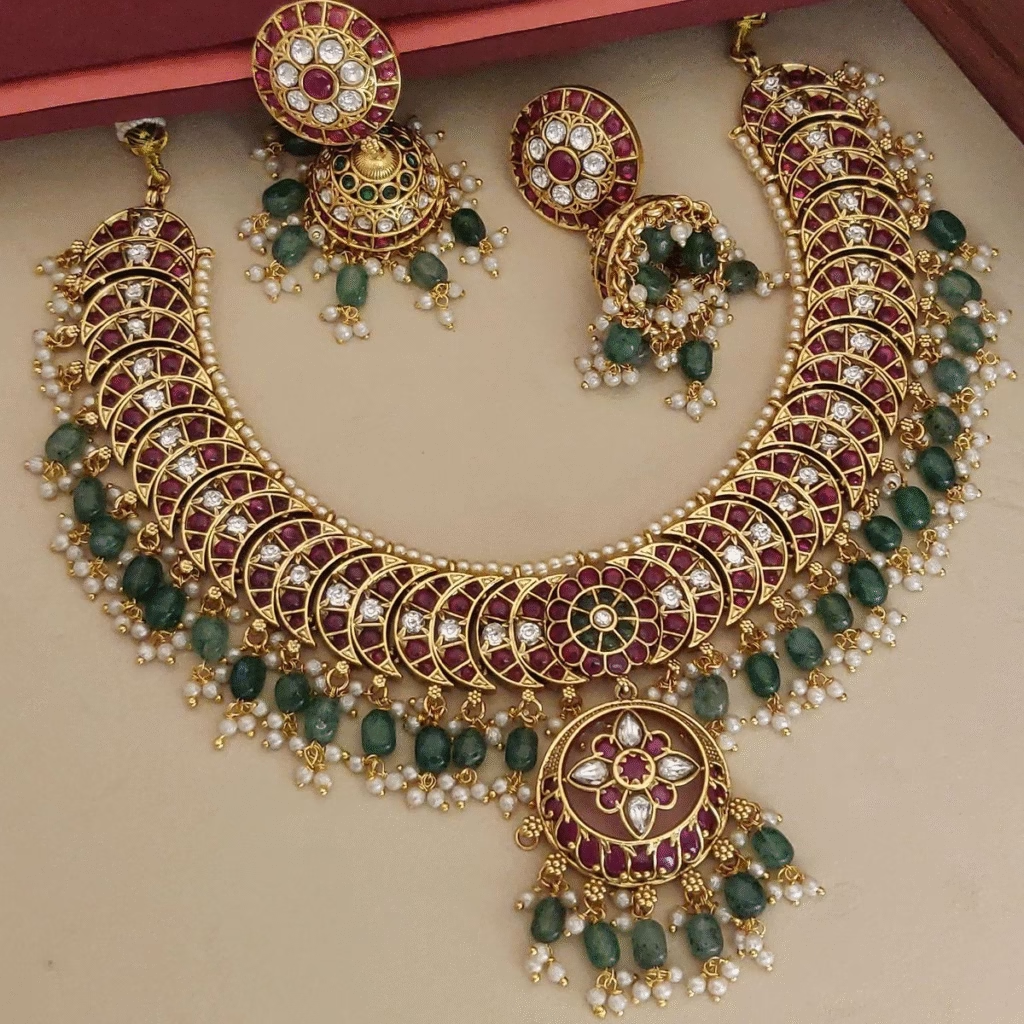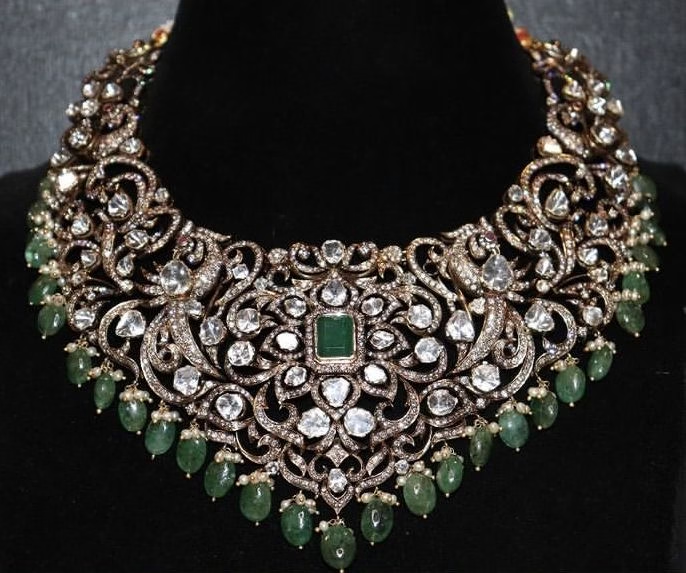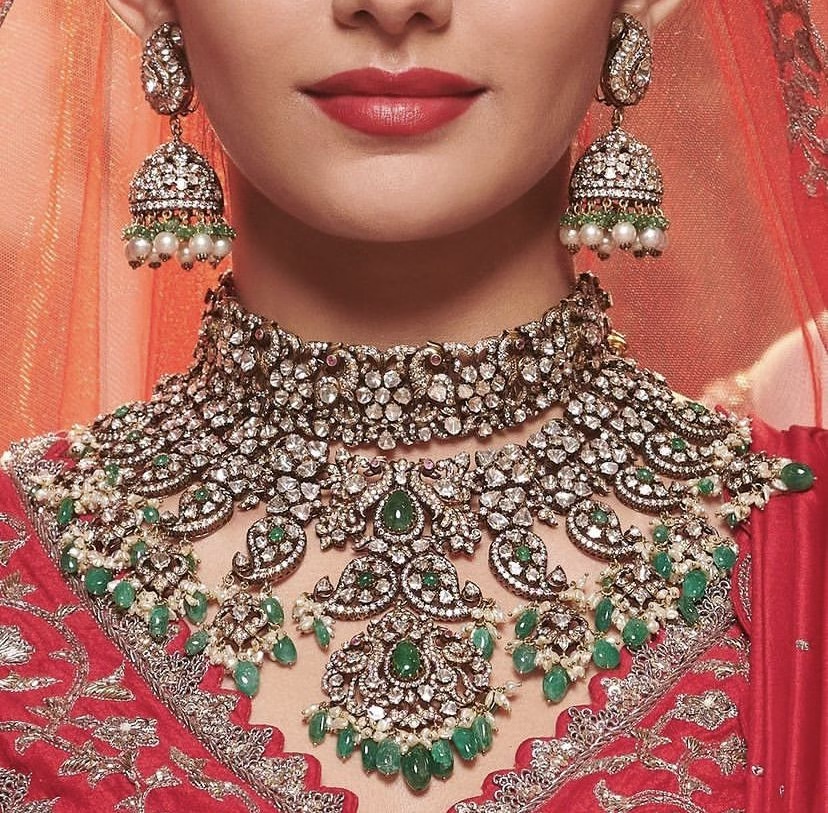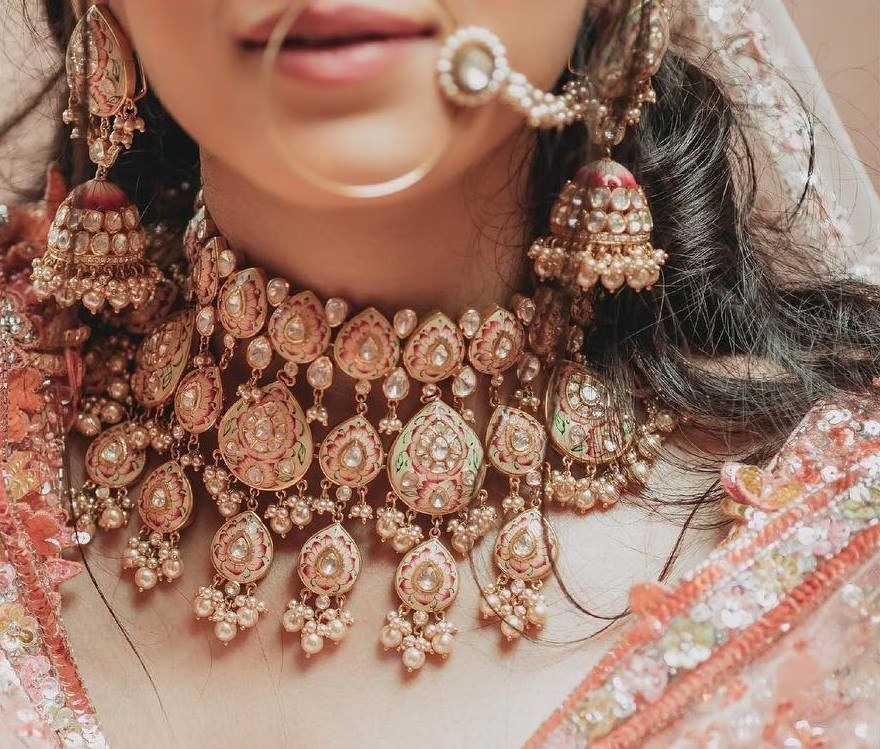Welcome to the dazzling world of Meenakari Jewelry, where tradition meets today’s trend of “less is more”! If you think Meenakari is just an old-school craft locked up in grandma’s treasure box, think again. This centuries-old art from Jaipur, famous for its bright enamel colors and intricate detailing, is now stepping into the world of minimalist jewelry with style.
Fun fact: Did you know Meenakari work dates back to the Mughal era, and Jaipur became its hub in the 16th century? Today, the Indian jewelry industry is valued at $78.5 billion (and growing!), and a fair chunk of that sparkle is thanks to Meenakari’s timeless charm.
The twist? Designers are now blending this royal craft into sleek rings, delicate pendants, and everyday earrings; proof that you can carry a piece of history without looking “too decked up.” So, let’s explore how Meenakari is sprinkling a little magic into the world of modern, minimalist jewelry!
What is Meenakari?
Ever wondered how jewelry can look like a painting you could wear? That’s exactly what Meenakari does! Originating in the Mughal era, Meenakari is the art of fusing bright, glossy enamel colors onto precious metals like gold, silver, or copper. Imagine a blank canvas, but instead of paint, artisans use powdered minerals, and instead of a frame, they use jewelry. Pretty artsy, right?
This craft isn’t just about looks; it’s about legacy. In fact, Jaipur became the center of Meenakari in the 16th century under Raja Man Singh of Amber, and since then, it has been a jewel (pun intended) in India’s cultural crown. Fun stat: India’s jewelry exports crossed $37 billion in 2024, and crafts like Meenakari Jewelry still hold a strong global demand. Today, this once-royal art is loved not just in wedding sets but also in chic everyday pieces like earrings and pendants. Clearly, Meenakari is proof that art never goes out of style—it just gets trendier!
Jaipur: The Heart of Enamel Art
If Meenakari were a Bollywood movie, Jaipur would be its superstar! Known as the “Pink City,” Jaipur is not only famous for forts and palaces but also as the beating heart of Meenakari Jewelry. Walk into the old lanes near Johari Bazaar, and you’ll find artisans still sitting cross-legged, using age-old techniques passed down for generations.
Here’s why Jaipur rules the Meenakari world:
- Royal Patronage – Mughal emperors and Rajput kings boosted the art here.
- Unique Designs – Bright reds, greens, and blues dominate Jaipur’s enamel palette.
- Skilled Artisans – Families have been practicing this craft for over 400 years.
- Global Reach – Jaipur exports tons of Meenakari Jewelry worldwide.
Today, Jaipur’s Meenakari is no longer limited to heavy bridal sets. Designers are giving it a modern twist, think minimalist pendants, dainty rings, and everyday earrings. So, whether you’re a bride or a college student, Jaipur has a piece of Meenakari magic just for you!
The Origins of Meenakari Craft

When we talk about Meenakari Jewelry, we often imagine glossy colors, intricate patterns, and a touch of royal flair. But this art didn’t just appear out of nowhere; it has roots as deep as history itself. The word Meenakari comes from the Persian word Mina, meaning heaven. Quite fitting, because honestly, those vibrant pieces do look heavenly. This craft first started as a way to decorate weapons, royal thrones, and palace walls before it found its way into jewelry boxes.
Imagine warriors swinging swords covered in enamel designs; talk about fighting in style! Over the centuries, Meenakari became more than decoration; it became a storytelling art. In fact, according to reports, India’s gem and jewelry export industry contributes over 7% to the country’s GDP, and traditional arts like Meenakari still play a huge part in preserving that shine. Now, let’s see how this colorful craft traveled and settled into the pink city, Jaipur.
How Meenakari Came to India
Meenakari was originally born in Persia and then introduced to India during the Mughal era. The Mughal emperors loved all things extravagant, whether it was grand palaces, delicate paintings, or jewelry dripping with details. So, they brought skilled artisans from Persia, and soon this art found a new home here. Over time, Indian craftsmen added their own twist, making the colors brighter, the motifs more detailed, and the jewelry more wearable for all occasions.
Key highlights about Meenakari’s arrival:
- Originated in Persia, perfected in India during the Mughal rule.
- Initially used for royal objects like swords, shields, and palace décor.
- Slowly adapted into jewelry, especially ornaments for queens and courtiers.
Jaipur’s Royal Connection with the Art
Jaipur isn’t just called the “Pink City” for its pretty walls, it’s also the beating heart of Meenakari Jewelry. In the 16th century, Raja Man Singh of Amber invited master artisans to Jaipur, making the city a hub for this craft. The royals adored the vibrant enamel, and soon Meenakari became a symbol of wealth and power. Even today, Jaipur holds a huge share in the traditional jewelry market, with more than 5000 artisans keeping the Meenakari tradition alive.
Highlights of Jaipur’s royal bond with Meenakari:
- Raja Man Singh’s patronage made Jaipur a center for the craft.
- The art became part of royal weddings and temple offerings.
- Today, Jaipur is still globally recognized for its fine Meenakari work.
Traditional Grandeur of Meenakari

When you think of Meenakari Jewelry, the word “minimal” is probably the last thing that comes to mind. Traditionally, this craft is all about grandeur, sparkle, and making jaws drop. Originating in the royal courts of Rajasthan, Meenakari was once created to decorate palaces, thrones, and temples before it found its way into jewelry boxes. Over centuries, it became the pride of Jaipur’s royal families, with artisans spending weeks, sometimes even months, to complete a single piece. That patience clearly paid off—because even today, when brides want to look like queens, Meenakari tops the list.
Statistics say that nearly 60% of Indian brides still prefer heritage jewelry like Kundan and Meenakari for their big day. Why? Because nothing screams “I’m the star of this wedding” louder than a vibrant, enamel-filled necklace that weighs almost as much as your wedding lehenga! In fact, Jaipur alone employs thousands of artisans, keeping the Meenakari tradition alive while adapting it to modern tastes.
Heavy Neckpieces and Statement Ornaments

Traditional Meenakari Jewelry isn’t for the faint-hearted—or weak-necked! Heavy chokers, grand Rani Haars, and chunky earrings have always been the highlight of this art form. These pieces were designed not just as ornaments, but as status symbols in royal courts. Imagine a king’s darbar where jewelry spoke louder than words—yes, that was the era of statement Meenakari.
Key highlights of traditional Meenakari ornaments include:
- Bold colors: Reds, greens, and blues dominate, making each piece a canvas of enamel art.
- Detailed motifs: Flowers, peacocks, and vines are common, adding a regal touch.
- Gold base: Traditionally set in gold, making them both valuable and breathtaking.
- Occasional mix with Kundan: A double dose of sparkle for the show-stopping effect.
Use in Bridal and Royal Jewelry
For brides, Meenakari isn’t just jewelry, it’s tradition wrapped in enamel and gold. From Rajput queens to today’s brides, heavy Meenakari sets continue to rule wedding trunks. Royals once wore them to flaunt power, and brides today wear them to flaunt glamour (and maybe test how strong their neck muscles are!).
Even now, bridal Meenakari sets often include:
- Layered necklaces
- Large jhumkas
- Mathapattis and bangles
- Anklets with enamel detailing
It’s safe to say that when it comes to weddings, Meenakari Jewelry still holds the crown, literally and figuratively.
Minimalism Meets Tradition
They say history repeats itself, but in fashion, history usually just reinvents itself. That’s exactly what’s happening with Meenakari Jewelry today. Once known for its bold colors, grand designs, and royal touch, this centuries-old art is now teaming up with the sleek trend of minimalism. It’s like pairing your grandmother’s treasured silk saree with a crisp white shirt, unexpected, yet fabulous! The best part? This blend of old and new is not just eye-catching but also highly wearable.
A recent report by McKinsey revealed that the global jewelry market is expected to hit $340 billion by 2030, with millennials and Gen Z driving the demand for lightweight, everyday-friendly designs. And guess what? Minimalist styles are leading the charge. The younger generation is no longer hunting for pieces that weigh more than their smartphones. Instead, they want jewelry that’s stylish, versatile, and Instagram-worthy, without needing a bodyguard to carry it around. This is where Meenakari steps in, adding heritage to simplicity.
Why Minimal Jewelry Is Trending
Minimal jewelry isn’t just a fashion statement; it’s a lifestyle shift. People are leaning towards clean, subtle designs because:
- They go with everything, from office wear to weekend brunch outfits.
- They are affordable compared to heavy, traditional sets.
- They can be worn daily without screaming “wedding season.”
- They fit into the modern idea of “quality over quantity.”
And when Meenakari Jewelry takes the minimal route, it brings a splash of vibrant enamel artistry without overwhelming the design. Imagine tiny enamel-detailed studs, slim bangles, or dainty pendants; pieces that quietly shine but never shout.
The Shift from Heavy to Everyday Wear
Gone are the days when jewelry was locked up in lockers, only to be taken out during weddings. According to a survey, 68% of young buyers prefer lightweight designs that can be worn daily. This explains the shift from chunky necklaces to sleek chains, from grand chandbalis to simple enamel hoops.
With Meenakari, artisans are crafting pieces that marry tradition with practicality. Think every day rings with a pop of Jaipur enamel, or delicate lockets that carry centuries of craftsmanship in a subtle form. It’s a tradition, but designed for your Monday meetings too.
Modern Designers Reinventing Meenakari

Who says tradition can’t get a trendy makeover? Meenakari Jewelry, once known for its heavy, ornate pieces, is now stepping onto fashion ramps and Instagram feeds with a modern twist. Designers are breaking the “only-for-weddings” stereotype and turning this centuries-old enamel art into everyday chic. According to the Indian jewelry export council, the country’s gems and jewelry market contributes over 7% to India’s GDP and Meenakari is a proud part of this glowing success story. No wonder designers are eager to reimagine it.
Instead of only creating grand sets for brides, today’s artisans are crafting minimalist rings, dainty chains, and office-friendly earrings. Think of it as the “Netflix reboot” of traditional jewelry, same essence, but sleeker, smarter, and binge-worthy for daily wear. From New York runways to Jaipur boutiques, Meenakari is proving that old is not just gold, it’s also stylish enamel with a new identity.
Contemporary Color Palettes and Styles
Modern Meenakari designs are no longer restricted to the traditional red, green, and blue shades. Designers are playing with pastel palettes, muted tones, and even metallic finishes. This makes the jewelry versatile, wearable, and perfect for those who love subtle elegance.
Here’s how the style game has changed:
- Softer hues like blush pink, mint green, and ivory are replacing bold shades.
- Minimalist motifs such as geometric shapes, florals, and abstract lines are in trend.
- Layered pieces are being designed for easy mix-and-match looks.
- Everyday-friendly designs fit well with both western and ethnic outfits.
This new approach has attracted younger buyers who prefer statement-making jewelry without the “too much sparkle” vibe.
Blending Meenakari with Gold, Silver, and Gemstones
The magic lies in the mix. By blending Meenakari with gold, silver, and even precious gemstones, designers are creating a hybrid that appeals to global tastes. Imagine a silver pendant with pastel enamel or a gold ring with tiny gemstones highlighting its Meenakari work.
Trends shaping this blend include:
- Gold-based Meenakari Jewelry with pearls for luxury wear.
- Silver with pastel enamel for chic, budget-friendly options.
- Gemstones like emeralds and sapphires enhancing the enamel work.
This reinvention has made Meenakari not just an art of the past, but a living, breathing style statement of the present.
Styling Meenakari the Minimalist Way
When you hear Meenakari Jewelry, you probably imagine heavy, traditional sets worn by brides or queens in old Bollywood movies. But here’s the twist, today, this centuries-old craft from Jaipur is entering the world of minimalism. Designers are shaping enamel art into light, chic pieces that you can wear every single day without looking like you’re heading to a wedding. According to a recent survey, over 65% of young Indians prefer minimalist jewelry for daily wear, and yes, Meenakari has joined the party.
Think of it this way: Meenakari is like that one talented cousin who can ace both classical dance and hip-hop, it fits in anywhere. The colors, the shine, and the elegance remain the same, but the designs are now sleek, subtle, and super wearable. Whether it’s a dainty ring for work, a pendant for brunch, or earrings for that casual date night, Meenakari is proving that tradition doesn’t need to scream to be noticed.
Everyday Jewelry: Rings, Pendants, and Earrings
Minimalist Meenakari Jewelry is the perfect choice for daily wear because it combines beauty with comfort. These pieces are light on the skin, easy to carry, and add just the right amount of sparkle and color without being too heavy or flashy. If you want to look stylish in your everyday outfits without going over the top, these designs are your best pick.
- Rings: Sleek enamel rings with delicate Meenakari work can instantly lift a simple office outfit. They give a polished, classy touch and make your hands look graceful even when you’re just typing on your laptop or holding a cup of tea.
- Pendants: Small, colorful pendants with fine Meenakari detailing are great for casual looks. They brighten up plain tops, dresses, or even formal shirts, adding a hint of tradition to modern clothing.
- Earrings: Subtle studs or tiny hoops decorated with Meenakari patterns are perfect for those who love elegance without fuss. They’re comfortable, timeless, and ideal for all-day wear.
Pairing Enamel Art with Western Outfits
Who says traditional art can only shine with sarees and ethnic wear? Meenakari Jewelry has broken those boundaries and now looks equally fabulous with Western outfits. The charm of colorful enamel work lies in its versatility; it works like a stylish statement accessory that adds personality to even the simplest modern looks. Whether you’re dressing up for work, a party, or just a casual outing, pairing Meenakari with jeans, dresses, or blazers can instantly make your outfit more eye-catching.
- Pendants: A pastel-colored Meenakari pendant paired with a crisp white shirt creates a chic and polished vibe. It’s simple yet stylish, making it perfect for office wear or coffee dates.
- Earrings: Enamel earrings with bold shades look striking against a black dress. They add just the right amount of drama while keeping the elegance intact.
- Rings: Minimalist Meenakari rings go perfectly with Western casuals like denim and t-shirts, offering a pop of tradition in a modern style.
Perfect Gifts with a Touch of Tradition
If you’re searching for a thoughtful present that blends elegance with meaning, Meenakari Jewelry is a wonderful choice. These minimalist pieces are not only stylish but also carry a sense of cultural heritage, making them stand out from regular accessories. In fact, studies show that nearly 48% of women prefer jewelry as a gift, and enamel art pieces strike the perfect balance between tradition and modern fashion trends. Whether it’s a birthday, anniversary, or festive occasion, gifting Meenakari is like giving a piece of timeless art.
- Affordable yet classy: Meenakari Jewelry offers options for every budget. Even simple pieces look rich and artistic, making them a premium-looking gift without overspending.
- Works for all ages: From young girls who love colorful designs to older women who cherish cultural elegance, these pieces suit everyone.
- Symbol of heritage with modern appeal: Each piece reflects India’s artistic roots while fitting seamlessly into today’s minimalist fashion trends.
The Future of Meenakari in Global Fashion
The charm of Meenakari Jewelry has traveled a long way from Jaipur’s royal courts to Instagram feeds and international runways. What was once considered “bridal-only bling” is now making waves in the global minimalist fashion scene. The world is leaning toward slow fashion, unique craftsmanship, and pieces that tell a story.
And guess what? Meenakari checks all the boxes. According to reports, the global jewelry market is expected to touch $330 billion by 2026, with handmade and artisan-based jewelry grabbing a noticeable share. That means Meenakari is not just surviving; it’s thriving and getting a makeover that blends tradition with trend.
Designers are experimenting with pastel shades, subtle enamel detailing, and lightweight pieces that suit everyday wear. So, whether you’re attending a wedding in Jaipur or sipping coffee in New York, Meenakari Jewelry is fast becoming a symbol of heritage that fits right into the global conversation of style, culture, and sustainability.
Sustainability and Handmade Appeal
Today’s fashion-conscious buyers aren’t just asking “how does it look?”—they’re asking “how was it made?” This is where Meenakari Jewelry shines bright. Handmade, eco-friendly, and deeply cultural, it perfectly aligns with the modern love for sustainable fashion. Mass-produced accessories may look trendy, but they can’t match the soul of handcrafted pieces.
- Crafted by skilled Jaipur artisans, each Meenakari design is unique
- No two pieces look exactly the same, adding charm and exclusivity
- Handmade jewelry reduces industrial waste compared to machine-made options
- Buyers are increasingly willing to pay for eco-friendly luxury
As the global demand for ethical fashion grows, Meenakari Jewelry is stepping up as a strong contender.
Jaipur Artisans Reaching the World Market
Earlier, Jaipur’s Meenakari artisans relied only on local buyers or wedding seasons. But thanks to digital platforms, they now sell directly to customers across the globe. A study shows that over 35% of handcrafted jewelry sales in India are now happening online, and exports are rising every year. With platforms like Etsy, Instagram shops, and luxury fashion collaborations, Jaipur’s artisans are showcasing their heritage to a worldwide audience.
- Online markets are breaking geographical barriers
- International buyers are drawn to the story behind each piece
- Collaborations with global designers are pushing Meenakari into luxury fashion
The road ahead looks bright, as Meenakari Jewelry isn’t just jewelry anymore, it’s cultural storytelling wrapped in enamel and metal.
Final Takeaway
Meenakari Jewelry has truly proven that tradition never goes out of style; it just finds new ways to shine. What once decorated kings, queens, and royal palaces is now winning hearts in modern, minimalist fashion. From heavy bridal sets to dainty rings and pendants, this art has traveled a long journey and is still evolving.
The beauty of Meenakari lies not only in its colors and patterns but also in the stories and skills of Jaipur’s artisans who keep the craft alive. As the global jewelry market grows, people are choosing designs that are sustainable, handmade, and meaningful. This is exactly where Meenakari fits in.
It blends heritage with modern style, making it perfect for today’s generation that values both tradition and trend. Whether you are gifting, styling for everyday wear, or adding a cultural touch to global fashion, Meenakari Jewelry will always remain a timeless piece of art with a modern heartbeat.
Visit our Traditional Art Blog to read them all in a simple, fun way.


Leave a Reply